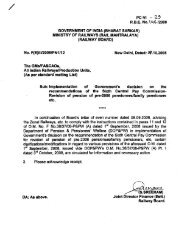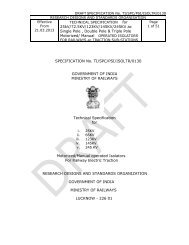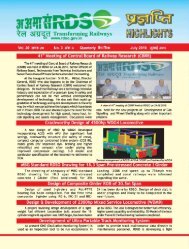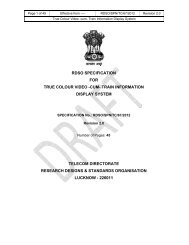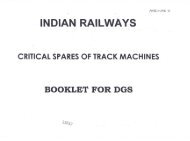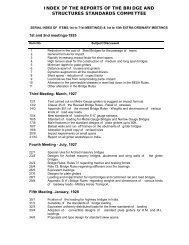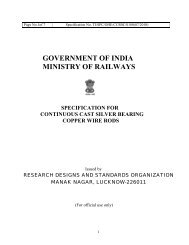Specification - rdso - Indian Railway
Specification - rdso - Indian Railway
Specification - rdso - Indian Railway
Create successful ePaper yourself
Turn your PDF publications into a flip-book with our unique Google optimized e-Paper software.
Government of India<br />
Ministry of <strong>Railway</strong>s<br />
SPECIFICATION<br />
FOR<br />
Page 1 of 13<br />
WD-23-BMBS-2008<br />
BOGIE MOUNTED BRAKE SYSTEM<br />
FOR FREIGHT STOCK<br />
FITTED WITH<br />
CASNUB TYPE BOGIE<br />
WAGON DIRECTORATE<br />
RESEARCH DESIGN & STANDARDS ORGANISATION<br />
MANAK NAGAR, LUCKNOW-226 011<br />
Feb, 2009 Price Rs. 1300/-
1. SCOPE<br />
This specification covers the technical requirements of bogie mounted air brake<br />
system (BMBS) for wagons fitted with Casnub Bogies. This specification is<br />
applicable for fitment of BMBS during manufacturing of new wagons as well as<br />
for retrofitment of BMBS on existing in-service wagons (with minimum axle load<br />
of 20.32 T).<br />
2.0 SYSTEM REQUIREMENTS<br />
2.1 The bogie mounted brake system shall be suitable for existing wagons fitted with<br />
all variants of Casnub bogies. These bogies are provided with spring plank. Other<br />
parameters of the casnub bogies are as follows: -<br />
1. Wheel diameter<br />
a) New 1000mm<br />
b) Condemning 906mm<br />
2. Type of brake block ‘K’ type non-asbestos composition<br />
brake block with 58mm thickness &<br />
condemning size 10 mm<br />
3. Brake Block Force (per wheel) 2110 Kg (±50 Kg)<br />
2.2 General arrangement of Bogie mounted brake system shall be as per RDSO’s<br />
drawing number WD- 08093-S/2.There will be one brake cylinder and one slack<br />
adjuster per bogie.<br />
2.2.1 The brake system shall be suitable for working with single pipe graduated release<br />
air brake system conforming to RDSO specification No. 02-ABR-02(latest) except<br />
for Brake Cylinder and Automatic Brake Cylinder Pressure Modification device<br />
(APM). Brake cylinder can be of manufacturer’s design, the details (drawings,<br />
etc.) of which will be furnished by the manufacturer. In case brake cylinder is a<br />
patented item, the supplier will furnish the patent details along with current status<br />
and validity date etc.<br />
2.2.2 Brake system shall be provided with brake cylinder having inbuilt double acting<br />
automatic slack adjuster having minimum slack take up capacity of 500mm.<br />
2.2.3 The brake head and other accessories for fitment of ‘K’ type composition brake<br />
blocks shall be in accordance with RDSO specification No. WD-22-Brake head-<br />
97 (rev.1) or latest amendment and brake block as per WD-14-ABR-2007 or<br />
latest amendments.<br />
2.3 The bogie mounted brake system shall be compatible with air brake equipment as<br />
per RDSO <strong>Specification</strong> No. 02-ABR-02(latest). Any changes to be made in the air<br />
brake equipment shall be specifically indicated by the supplier.<br />
2.4 Air Brake Pipe layout and fitment of Air Brake Equipments shall be as per<br />
respective drawings of individual wagons, which will be issued by RDSO, Lucknow.<br />
Page 2 of 13
2.5 All air brake pipes and fittings shall be of stainless steel specification no. 04-ABR-<br />
2002(latest).<br />
3.0 BOGIE DETAILS<br />
3.1 Wagons on which bogie-mounted air brake system shall be provided are fitted<br />
with Casnub type bogies. Details of these bogies i.e. drawings etc. can be<br />
obtained on payment basis from RDSO, Lucknow.<br />
3.2 The complete weight particulars per wagon of offered bogie mounted brake<br />
system shall be furnished by the supplier.<br />
4.0 TECHNICAL REQUIREMENTS<br />
4.1 One number of 10” size brake cylinder (two numbers per wagon) shall be used<br />
on each bogie. These brake cylinders shall have built in double acting slack<br />
adjusters. Mounting of the brake cylinders has been done on one of the two<br />
brake beams fitted in each bogie. Each brake cylinder controls the braking on two<br />
wheel sets of a bogie.<br />
4.2 One brake cylinder shall have provision for hand brake cables and the other shall<br />
be without hand brake.<br />
4.3 Design of the brake cylinders shall be as per firm’s own design. However, the<br />
brake cylinder shall fit within space envelope as shown in RDSO’s drawing<br />
number WD-08095-S-01and S-02.<br />
4.4 Minimum brake cylinder piston travel of the bogie mounted brake cylinders must<br />
be sufficient to provide proper brake shoe clearance when brakes are released.<br />
Maximum piston stroke of the brake cylinder shall be 56 mm in empty and loaded<br />
condition.<br />
4.5 The brake cylinder must generally meet the requirements of Leakage test,<br />
Environmental test, Cycle test and Vibration test as per the test scheme given in<br />
Annexure-II.<br />
4.6 The brake cylinder shall give trouble free service without any attention for a<br />
period of six years. The vendor shall submit detailed maintenance instructions of<br />
the brake cylinder. These maintenance instructions shall be followed at the time<br />
of overhauling of the brake cylinders.<br />
4.7 Brake beams (outline) shall be as per RDSO’s drawing number WD-08093-S/2.<br />
The brake beam manufactured by the firm shall be subjected to load-deflection<br />
and fatigue testing as per test scheme given in Annexure-I.<br />
4.8 High friction composition brake blocks of “K” type to RDSO’s specification WD-<br />
14-ABR-2007(latest) has been used in the BMBS.<br />
Page 3 of 13
4.9 Two stage Automatic Brake Cylinder Pressure Modification Device (APM)<br />
whose functioning based on the gap between underframe and bogie side frame<br />
of the wagon shall be as per firm’s own design. APM should sense the gap only<br />
at the time of air brake application. During remaining time it should not be in<br />
contact with the bogie side frame. APM shall be a proven design and must meet<br />
the space envelope shown in RDSO’s drawing number WD-08096-S-01.One<br />
number of APM shall be used per wagon. No human intervention shall be<br />
required for operation of APM.<br />
4.10 APM shall ensure brake cylinder pressure of 3.8 Kg/cm 2 when the gap between<br />
wagon underframe and bogie side frame is as prescribed in applicable drawings.<br />
After the gap between underframe and bogie side frame becomes more than as<br />
prescribed in the applicable drawings, the brake cylinder pressure shall be<br />
reduced to 2.2 Kg/cm 2.<br />
4.11 Performance testing of APM shall generally conform to AAR standard S-4002<br />
(Latest). Specific procedure and parameters for testing shall be prescribed by the<br />
contractor/manufacturer and will be approved by RDSO.<br />
4.12 Complete arrangement of hand brake shall also be part of BMBS. Hand brake<br />
shall be provided on one of the two bogies. The hand brake shall be operated as<br />
shown in the general arrangement drawing of the wagon fitted with BMBS.<br />
4.13 Complete BMBS shall be generally tested as per AAR standard S-4005 [Latest<br />
revision]. Specific procedure and parameters for testing shall be as per the<br />
scheme given in Annexure-II. This testing shall be carried out after installing the<br />
entire BMBS in a suitable bogie or in a suitable test fixture that duplicates the<br />
dimensions and geometry of the bogie.<br />
4.14 Air Brake Pipe layout arrangement and fitment of air brake equipment which are<br />
fitted on the underframe may vary from one type of wagon to another. Such<br />
drawings of different type of wagons shall be issued by RDSO separately.<br />
4.15 All pins connecting to brake cylinder, bell crank levers, push rods and brake<br />
beams shall be secured by a suitable anti pilferage device (APD). A proper APD<br />
for Automatic Brake Cylinder Pressure Modification Device (APM) is also to be<br />
provided.<br />
5.0 QUALIFYING REQUIREMENT<br />
5.1 The manufacturer willing to supply the brake cylinder with inbuilt slack adjuster<br />
(double acting) should have collaboration agreement with manufacturers having<br />
AAR/UIC approval for same /similar item.<br />
5.2 Such manufactures, who will be called “Principle manufacturers”, should agree to<br />
provide technology to at least two or more manufacturers, who will be called<br />
“Licensee manufacturers” .The vendor approval for all manufacturers will be as<br />
per Vendor Approval Procedure of RDSO.<br />
Page 4 of 13
5.3 The licensee manufacturer shall have the certificate of approval from the principle<br />
manufacturer and the same shall be submitted to RDSO.The principle<br />
manufacturer will also give a certificate certifying that the licensee manufacturer<br />
has the same testing/manufacturing facilities(machine and plant) as those with<br />
the principal manufacturer.<br />
5.5 The manufacturers (principal as well as licensee manufacturers) shall have to<br />
enter into Running Maintenance Contract of the equipment with the <strong>Railway</strong>s.<br />
Such contract will be for overhauling of equipments, out of course repair and<br />
testing of equipment.<br />
6.0 PROCEDURE OF TECHNICAL CLEARANCE<br />
If the applicant satisfies the Qualifying Requirements as laid down in Para 5.0<br />
Development Inspection as mentioned below shall be carried out.<br />
6.1 DEVELOPMENTAL INSPECTION<br />
Developmental inspection shall be carried out at the manufacturer’s premises at<br />
the time of registration of the firm with RDSO. The following procedure shall be<br />
followed for the developmental Inspection:<br />
6.1.1 The inspecting authority shall verify and ensure that the manufacturer has<br />
Infrastructure strictly following a well documented system of the Internal Quality<br />
Assurance Plan.<br />
6.1.2 The manufacturer shall offer FIVE BMBS sets complete in all respects. The<br />
procedure for all the tests for testing of BMBS has been listed in Annexure I&II.<br />
6.1.3 In case samples offered fail in any of the test/check, the firm shall be advised<br />
accordingly.<br />
6.2 FIELD TRIAL<br />
6.2.1 Once the developmental tests have been cleared, prototype fitment of BMBS<br />
shall be done by the supplier on a single bogie in their premises. After<br />
demonstrating satisfactory working of the system, the supplier shall make<br />
arrangements for the fitment of the above equipment on a complete wagon<br />
6.2.2 For those Principle manufacturers who have not supplied BMBS (of same/similar<br />
design as laid down in RDSO’s drawing number WD- 08093-S/2 for wagons) to<br />
<strong>Indian</strong> <strong>Railway</strong> in the past, field trial of the wagons fitted with BMBS shall be<br />
conducted to assess the system reliability of these wagons .Field Trial shall be<br />
conducted for a period of 18 months.<br />
6.2.3 Only on successful completion of all the above steps the firm will be accorded<br />
technical clearance for becoming a vendor for BMBS. The vendor approval will<br />
be done after this as per Vendor Approval Procedure of RDSO.<br />
Page 5 of 13
6.3 PURCHASE INSPECTION<br />
Purchase inspection shall be carried out at the premises of manufacturer who<br />
are cleared for the regular manufacture of BMBS.For each type of wagon<br />
prototype fitment of BMBS shall be done and cleared by RDSO during purchase<br />
inspection. If the prototype for that type of wagon has been earlier cleared by<br />
RDSO for that firm, then the same will not be required to be done again. The<br />
following procedure shall be followed for the purchase inspection:<br />
6.3.1 The inspecting authority shall make audit checks of the manufacturing<br />
procedure / Internal Quality Assurance system to ensure that the BMBS<br />
offered for inspection is manufactured strictly as per internal quality assurance<br />
system and the manufacturer has carried out all tests / inspection during<br />
manufacturing stage to ensure that BMBS offered are strictly to the<br />
specification. During such audit checks, the inspecting authority shall also check<br />
the records of internal quality assurance.<br />
6.3.2 The inspecting authority shall conduct the checks/tests as given below from the<br />
offered lot.<br />
6.3.3 Components of 2% of the offered lot of BMBS subject to minimum two BMBS<br />
randomly picked up shall be checked for dimensions with respect to assembly<br />
drawing.<br />
6.3.4 1% of brake cylinder of the offered lot subject to minimum one brake cylinder shall<br />
be dismantled and dimensions and general workmanships of each component<br />
shall be checked as per the component drawings.<br />
6.3.5 The manufacturer shall ensure that all the brake beams are subjected to Static<br />
Tests of para 1.1 & 1.2 as laid down in test scheme (Annexure-I). During the<br />
purchase inspection 1% brake beams (picked up randomly) of the offered lot<br />
subject to minimum two number will be subjected to these tests under the<br />
supervision of the inspecting authority.<br />
6.3.6 Safety factor test (para 1.3 of Annexure –I), Bend tests (para 2 of Annexure-I),<br />
Dynamic test (para 3 of Annexure –I) on brake beams shall be conducted under<br />
the supervision of inspecting authority at periodic interval of one year. Same<br />
brake beam may be used for para 1.3 and 2. Separate brake beam shall be used<br />
for dynamic test. The brake beams tested under 6.3.6 shall not be allowed to use<br />
on IR and shall be scraped. Record of last test conducted shall be given by the<br />
manufacturer to the inspecting authority during purchase inspection.<br />
6.3.7 The manufacturer as a part of its internal testing scheme shall conduct Leakage<br />
Test at room temperature for all the brake cylinders on routine basis as given in<br />
Annexure-II. During the purchase inspection one brake cylinder out of every<br />
2000 brake cylinders being manufactured will be subjected to Leakage Test (for<br />
the complete temperature range as given in Annexure-II) under the supervision<br />
of the inspecting authority. If a manufacturer manufactures less than 2000 brake<br />
Page 6 of 13
cylinders in a year than the test is to be conducted at least once(for the complete<br />
temperature range as given in Annexure-II) in that year.<br />
6.3.8 Environmental Test, Endurance Test, Vibration Test of brake cylinder and<br />
Function test of BMBS shall be conducted under the supervision of inspecting<br />
authority at periodic interval of one year. Record of last tests conducted shall be<br />
given by the manufacturer to the inspecting authority during purchase inspection.<br />
.<br />
6.3.9 Manufacturer shall ensure that all APM’s shall be subjected to RDSO approved<br />
tests as laid down in Para 4.11. During the purchase inspection 2 % APM’s<br />
(picked up randomly) of the offered lot subject to minimum two number will be<br />
subjected to this test under the supervision of the inspecting authority.<br />
6.3.10 In case the component samples picked up fail in any of the tests / checks<br />
indicated in para 6.3.3 to 6.3.9 the reasons for such failure shall be<br />
Identified. The inspecting authority shall verify the reasons by conducting<br />
audit check on internal quality assurance system. If it is found that such failures<br />
are due to non implementation of internal quality assurance system, the entire lot<br />
of BMBS shall be rejected. In case the failures are on account of reasons other<br />
than non implementation of internal quality assurance system, the manufacturers<br />
may re-offer the lot after rectifying the defects. However, in such cases, double<br />
the quantity of samples shall be picked up and tests/checks shall be conducted.<br />
In case the samples again fail in any of the tests/checks, the entire lot shall be<br />
rejected.<br />
6.3.11 The manufacturer will maintain a list of all internal acceptance tests being carried<br />
out at various stages of manufacturing of the product. Proper record of such<br />
internal acceptance tests shall be maintained and also included in the QAP.At the<br />
time of inspection of the product, these records shall be put to the inspecting<br />
authority for scrutiny and countersign.<br />
7.0 TRAINING<br />
Maintenance staff in wagon depots/workshops, wherever the wagons fitted with<br />
BMBS are required to be maintained, will be trained in maintenance aspects of<br />
BMBS. Manufacturer in association with Wagon directorate, RDSO, Lucknow and<br />
Zonal <strong>Railway</strong>s shall arrange this training.<br />
8.0 MARKING AND PACKING<br />
8.1 Each major component of the bogie mounted brake system should have<br />
prominent and durable marking as follows: -<br />
• Manufacturer’s name (initials/trade mark can also be marked)<br />
• Month and the year of manufacture.<br />
• Country of origin (in case of imported components)<br />
• Serial No.<br />
8.2 The components shall be suitably packed to make them fit for transit by<br />
Rail/Road/Sea/Air without any damage and also for storage.<br />
Page 7 of 13
9.0 AFTER SALES<br />
9.1 The manufacturer/contractor shall arrange for adequate service engineers at his<br />
own cost to ensure that the equipment supplied performs satisfactorily.<br />
Manufacturer/Contractor shall also depute his staff on request by the Purchaser /<br />
RDSO, to investigate and attend to specific problems that may come up during<br />
actual operation of Air Brake Equipment.<br />
9.2 The manufacturer/contractor shall arrange to supply along with the equipment<br />
maintenance manuals, wall charts and cut models for proper maintenance of his<br />
own proprietary equipment. Two numbers of manuals and wall charts per 100<br />
number of BMBS or part thereof and cut model one each per 2000 number of<br />
BMBS or part thereof shall be supplied against every contract free of cost. The<br />
consignee for these shall be nominated by RDSO. Manuals shall be illustrated,<br />
containing information pertaining to the principle of operation, maintenance<br />
schedule of all the proprietary items of equipment being supplied. The Manual<br />
shall also contain information on the following: -<br />
a) Details of attention during various schedules of Examination.<br />
b) Test equipments.<br />
c) Special tools<br />
d) Trouble shooting<br />
e) List of spares required during various schedules of Examination.<br />
f) Updated position of modifications carried out.<br />
9.3 The manufacturer/contractor shall supply revised Maintenance Manuals and Wall<br />
Charts incorporating necessary changes in the Manuals and Wall Charts already<br />
supplied by them for earlier contracts. The copies of maintenance manuals and<br />
wall charts are meant for wider circulation on <strong>Railway</strong> and fresh copies shall be<br />
furnished as stipulated even if there are no changes in the manuals & wall charts<br />
furnished against earlier contract.<br />
10. GUARANTEE/WARRANTY<br />
The firm shall stand guarantee, unless otherwise specified in the specification of<br />
individual component/sub assembly, for a period of 36 (thirty six) months form the<br />
date of fitment of the system.<br />
In case of any premature failure of any components due to design/manufacturing<br />
deficiency, firm will be liable to make free replacement within reasonable time to<br />
the depot where failure has been reported. Whenever repeated failures are<br />
reported, firm shall investigate and come up with satisfactory reasons for failure<br />
and take remedial action. The failed component/sub assembly (within the<br />
warranty period) shall be taken back by the supplier for repair and re-supply to<br />
the <strong>Railway</strong>s after RDSO Inspection along with an extended warranty period as<br />
applicable to the new supply.<br />
This will not exclude satisfactory performance of brake cylinders for a time<br />
period of six years in <strong>Indian</strong> environmental and working conditions.<br />
Page 8 of 13
TEST SCHEME FOR BRAKE BEAM OF BMBS FOR WAGONS<br />
Page 9 of 13<br />
ANNEXURE-I<br />
The following tests are to be carried out on both the brake beams (Primary<br />
and Secondary) for BMBS application on <strong>Indian</strong> <strong>Railway</strong>s.<br />
1. STATIC TESTS.<br />
2. BEND TESTS OF BRAKE BEAM ENDS<br />
3. DYNAMIC TEST.<br />
1. STATIC TESTS<br />
The test fixture shall have suitable supports to represent the back of brake<br />
shoe, so that the brake beam can be mounted in the fixture, supported on<br />
brake heads.<br />
Deflection measurement test<br />
Set test<br />
The brake beam is to be loaded for a load of 10.8t at load application points<br />
of the brake beam for three consecutive load cycles. At the end of third<br />
cycle the load is to be reduced to 500kg to set the deflection reading to<br />
zero. Then the deflection load of 10.8t is to be re-applied and deflection<br />
reading at center is to be taken which should not be more than 1.8 mm.<br />
After deflection test, the beam shall be loaded for a set load of 16.2t and<br />
then released to 500 kg. The brake beam shall not show a set more than<br />
0.25mm.<br />
Safety factor test<br />
The brake beam is to be subjected to a safety factor test to withstand a load<br />
of 24.2t with deflection not more than 50 mm and without failure of any of<br />
the parts.
2. BEND TESTS OF BRAKE BEAM ENDS<br />
Proof load test<br />
The brake beam shall be supported in a fixture with the brake heads against<br />
dummy brake shoes and a deflection load of 10.8t is to be applied on it to<br />
hold the brake beam in position. Then by means of a clamp fixture attached<br />
to the brake beam end, a load of 2t at each end is to be applied through a<br />
distance of 110mm from brake head centre.<br />
Safety factor test<br />
After this the load of 2t is to be reduced to 200 kg and measure the set as<br />
zero. Then apply a load of 3t at each the ends and measure the set by<br />
reducing the load to 200kg, which shall not be more than 0.18mm.<br />
After successful set test, a load of 4.5t is to be applied for safety factor<br />
test. There shall not be any type of failure of brake beam ends.<br />
3. DYNAMIC TEST<br />
The beam shall be loaded for one million cycles at a frequency range<br />
between 1Hz to 3 Hz<br />
Page 10 of 13
3.1 The beam shall be mounted in a suitable cycle machine capable for 10.8t<br />
deflection load at push rod connections on brake beam.<br />
3.2 A tangential load of 2t must be applied at each brake head simultaneously<br />
with deflection load and this load must be reacted at brake beam ends.<br />
The reaction load shall be applied through suitable brake beam guide of<br />
dimensions described in item 9 of drg. No. SK 69597.<br />
3.3 The tangential load must alternate in direction with each normal load<br />
cycle.<br />
3.5 Failure is defined as complete breakage of any component, part of the<br />
beam or when such weakness has been developed that the beam can no<br />
longer sustain the test load.<br />
********<br />
Page 11 of 13
BMBS System Function Tests<br />
Page 12 of 13<br />
Annexure-II<br />
a) Install the system in the suitable text fixture that duplicates the complete set of<br />
system and make sure all the adjustments are correct.<br />
b) For the minimum slack clearance use max. thicknesses of brake block and keep<br />
the brake cylinder between the mounting holes/pins. Retract the system back<br />
until max. show clearance is obtained.<br />
c) Apply 0.7 Kg/Cm2 air pressure to the brake cylinder and note that all the brake<br />
blocks are touching the wheel.<br />
d) Apply 3.8 Kg/Cm2 air pressure to the brake cylinder and record the brake block<br />
force at each brake head with-out rapping the rigging. Then rap each friction<br />
point of the system and again record the brake block force at each brake head.<br />
These reading will be used to compute the efficiency of the bogie mounted brake<br />
system in the static and simulated dynamic conditions.<br />
e) Removing a brake block, apply and release 0.7 Kg/Cm2 air pressure to the brake<br />
cylinder until the brake heads touch the wheel with correct piston stroke. Repeat<br />
the procedure until all brake blocks have been removed.<br />
f) Install a brake block, apply and release 0.7 Kg/Cm2 air pressure to the brake<br />
cylinder until the brake heads are brought up against the wheel with correct<br />
piston stroke. Repeat the procedure until all brake blocks have been installed.<br />
Brake Cylinder (with Built in Slack Adjuster) Testing<br />
Leakage Test for Brake Cylinder complete<br />
Apply 0.7 Kg/Cm2 & 3.8 Kg/Cm2 air pressure and wait 5 minutes after application<br />
and observe that the leakage is not more than as given in table below.<br />
Brake Cylinder Pressure Temp* Maximum leakage rate<br />
0.7 Kg/Cm2<br />
3.8 Kg/Cm2<br />
-10 o C 0.07 Kg/Cm2 in 10 minutes<br />
21 o C 0.03 Kg/Cm2 in10 minutes<br />
55 o C 0.03 Kg/Cm2 in10 minutes<br />
-10 o C 0.03 Kg/Cm2 in10 minutes<br />
21 o C No. leakage in 10 minutes<br />
55 o C No. leakage in 10 minutes<br />
*During routine test (internal test to be done by the manufacturer) the leakage test will be<br />
conducted for all the brake cylinders at room temperature of 21 o C.<br />
Environmental Test<br />
Measure brake cylinder force output and efficiency at 3.8 Kg/Cm2 in room<br />
temperature (21 o C), 55 o C and -10 o C or below. Efficiency shall be measured by<br />
comparing the air pressure force on the piston to the total brake block force. If<br />
efficiency is measured in a text fixture the air pressure force on the piston will be
compared to the piston push rod force. All readings will be made after the friction<br />
points of the system have been rapped. Under no circumstance should the brake<br />
rigging be rapped in a manner that might artificially increase or reduce the brake<br />
block forces.<br />
Cycle Test/ Endurance Test<br />
a) Leakage test for brake cylinder complete and Environmental test at room<br />
temperature must be completed successfully both prior to and after completion of<br />
Cycle test/ Endurance test. Efficiency at the completion of Cycle test/ Endurance<br />
test must not decrease more than 2% if forces are measured at the pushrod, or<br />
5% if forces are measured at the brake block heads, for the efficiency measured<br />
prior to the cycle test.<br />
b) Cycle the brake cylinder with in built slack adjuster at a brake cylinder pressure of<br />
at 6.2 Kg/Cm2 for 200,000 cycles.<br />
c) Remove one brake block every 25,000 cycles until 125,000 cycles is reached<br />
and then add one brake block every 25,000 cycles for remainder of the test.<br />
d) Repeat the leakage test and Environmental test at room temperature (21 O C).<br />
e) Install the brake cylinder with built in slack adjuster in the text fixture with all<br />
associated components and perform a function test as described in System<br />
functional test.<br />
Vibration Test<br />
a) Leakage test for brake cylinder complete and Environmental test at room<br />
temperature must be completed successfully both prior to and after completion of<br />
the Vibration tests.<br />
b) Brake Cylinder with built in slack adjuster must be subjected to a vibration test at<br />
no less than 30 or more than 60 cycles per second at + 3g for Five million cycles.<br />
c) Repeat the leakage test and Environmental test at room temperature (21 O C).<br />
Efficiency at the completion of Vibration test must not decrease more than 2% at<br />
push rod from the efficiency measured prior to the Vibration test.<br />
d) Install the brake cylinder with built in slack adjuster in the text fixture with all<br />
associated components and perform a function test as described in System<br />
functional test.<br />
Page 13 of 13



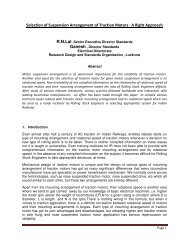

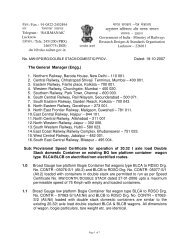
![Hkkjrljdkj] jsy ea= ky; vuql a/ kkuvfHkdYivkSj ekudlax Bu y ... - rdso](https://img.yumpu.com/21978459/1/184x260/hkkjrljdkj-jsy-ea-ky-vuql-a-kkuvfhkdyivksj-ekudlax-bu-y-rdso.jpg?quality=85)

